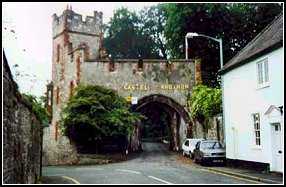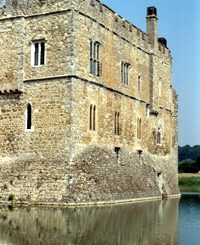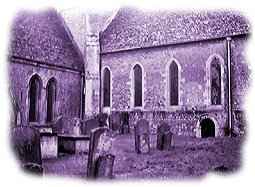Bolling Hall Museum
Now a museum, Bolling Hall, parts of which which date from the 14th century, is one of Bradford’s oldest buildings. It would also appear to have a reputation for being haunted and has a famous legend relating to a white lady in what is known as the Ghost Room. The story of the White Lady refers to a singular visit of an appartion to William Cavendish, 1st Duke of Newcastle-upon-Tyne (Born 6 December 1592 – Died 25 December 1676) begging him to spare the inhabitants of Bradford during the English Civil War. The following account of this was published in ‘The Haunted Homes and Family Traditions of Great Britain’ by John Ingram (1897).
Bolling, or Bowling Hall, near Bradford, the residence of J. M. Tankard, Esq., is a fine old manor-house in a very good state of preservation; the present owner having done everything to render it convenient and comfortable without sacrificing its ancient appearance. This Hall was formerly the abode of the Bollings; but in 1502 Rosamund Bolling, sole heiress of the property, carried it by marriage into the Tempest family, from whom it passed through the hands of several successive owners until finally it became the property of the present proprietor.
![StuartBurrows [CC BY-SA 3.0 (https://creativecommons.org/licenses/by-sa/3.0)], from Wikimedia Commons](http://www.mysteriousbritain.co.uk/wp/wp-content/uploads/2008/09/800px-Bolling_Hall-300x139.jpg) Some portions of this picturesque old place are very ancient; the embattled western tower, says Mr. William Scruton, to whom we are chiefly indebted for the information contained in this chapter, appearing, from its weather-beaten masonry and the thickness of its walls, to date not later than the reign of Edward the Third. Another tower of great antiquity flanks the other end of the fabric. That portion of the front which lies between the towers seems, from the ornate style of its architecture, to have been the work of earlier Tempests, and contains two large embayed windows, of which the western bay with heavy mullions is the window of “the ghost chamber.” This haunted room is above the breakfast room, and formerly communicated by a passage, now bricked up, with the kitchens and servants’ apartments. Its plaster ceiling is beautifully moulded, being covered with an elaborate tracery of conventionally treated branches bearing fruit and flowers, that, with the birds resting on them, issue out of the mouths of horses, boars, and other animals. The walls, which are covered with oak panels, painted a light colour, are surrounded by a curious cornice and frieze, consisting of human heads and grotesque animals in relief. The lofty carved oak mantelpiece is very remarkable; it is supported by two fluted columns, which support a canopy ornamented with oak and vine leaves and sprays, below which are portraits of Sir Richard Tempest and Rosamund his wife, painted on wood, and in a remarkably good state of preservation, considering the three centuries and a half which have elapsed since they were painted.
Some portions of this picturesque old place are very ancient; the embattled western tower, says Mr. William Scruton, to whom we are chiefly indebted for the information contained in this chapter, appearing, from its weather-beaten masonry and the thickness of its walls, to date not later than the reign of Edward the Third. Another tower of great antiquity flanks the other end of the fabric. That portion of the front which lies between the towers seems, from the ornate style of its architecture, to have been the work of earlier Tempests, and contains two large embayed windows, of which the western bay with heavy mullions is the window of “the ghost chamber.” This haunted room is above the breakfast room, and formerly communicated by a passage, now bricked up, with the kitchens and servants’ apartments. Its plaster ceiling is beautifully moulded, being covered with an elaborate tracery of conventionally treated branches bearing fruit and flowers, that, with the birds resting on them, issue out of the mouths of horses, boars, and other animals. The walls, which are covered with oak panels, painted a light colour, are surrounded by a curious cornice and frieze, consisting of human heads and grotesque animals in relief. The lofty carved oak mantelpiece is very remarkable; it is supported by two fluted columns, which support a canopy ornamented with oak and vine leaves and sprays, below which are portraits of Sir Richard Tempest and Rosamund his wife, painted on wood, and in a remarkably good state of preservation, considering the three centuries and a half which have elapsed since they were painted.
The last Tempest who held sway at Bolling Hall was Richard, styled by Markham “a weak, imprudent man, a Royalist and a gamester.” When the Puritan party finally triumphed, this Tempest compounded for his estates by a heavy fine, which, coupled with his gambling proclivities, led to his ruin. In the autumn of 1658 he died in the King’s Bench, a prisoner for debt. According to the current legend he staked and lost Boiling Hall and all his estates at cards, during the deal exclaiming:
“Now ace, deuce, and tray,
Or farewell, Bolling Hall, for ever and aye!”
No wonder if this Royalist reprobate’s uneasy spirit haunts its squandered-away Hall; but what his ancient dwelling is chiefly noted for is for an apparition which visited it, or, rather, rendered itself visible at the time of his ownership of the place.
During the Civil War Bradford was closely invested by the Royalists under the Earl of Newcastle. This nobleman, who had made Bolling Hall his head-quarters, being enraged at the slaughter of the Earl of Newport, prepared instructions for a general massacre of the inhabitants, men, women, and children; no quarter to be given to any. However, before the town capitulated, different orders were issued, and instructions given that none should be put to death. The reason of this great change of orders is generally attributed to supernatural intervention. Popular tradition declares that a female arrayed in white appeared in the Earl’s bed-chamber at Bolling Hall, and besought mercy for the townsfolk. According to the well-known account of Mr. Joseph Lister, who was in Bradford during the siege, “it was generally reported that something came on the Lord’s Day night, and pulled the clothes off his bed several times, and cried out with a lamentable voice ‘Pity poor Bradford!’ that then he sent out his orders that neither man, woman, nor child should be killed in the town; and that then the apparition which had so disturbed him left him and went away.”
There does not appear to be any record of another appearance of this apparition, but the story of its visit to the Earl is an old and widely-diffused one; wherefore it would not do to omit from this collection the account of “The Bolling Hall Ghost”.




Re: Bolling Hall Museum
‘Ghost’ captured in photograph taken at historic Bolling Hall
Friday 20th August 2010 by Hannah Baker – [The Telegrah and Argus]
Staring out from behind a bed post, surrounded by a yellow glow, is the tiny, pale face of what appears to be a young woman. But is she actually a phantom?
This creepy image was taken in the Ghost Room at Bradford’s most haunted building, Bolling Hall, believed to be the home of a mysterious white lady.
The photograph was given to the Telegraph & Argus by John Holmes, 65, who had visited the hall with a friend from Brazil.
Mr Holmes, 65, originally of Lister Hills, Bradford, said: “We took this photograph and it wasn’t until we put it on to the computer that we thought ‘what’s that?’ and started looking at it.
“I was like most people, I couldn’t believe it. I have felt a presence in that room before but I’ve never taken photographs.”
Mr Holmes returned to the hall and took photographs from several different angles to see whether the mysterious face could have been someone standing on the other side of a door by the bed.
He said: “In order to see through the door you would have to stand by the side of the bed.
We have taken photograph after photograph trying to disprove that this is a ghost. You can feel there’s definitely something in there. From the angle we took the photo you can’t see the door. We have taken pictures from every possible angle and you can’t see anything.”
This was the second ghostly encounter for Mr Holmes, who works in a public mortuary in London.
When he moved to his first home in the capital he saw a young girl brushing her hair on the end of his bed.
He discovered his house was built on the site of an old church and held a seance for her.